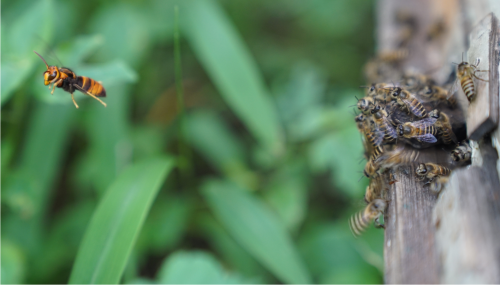In the arms race between prey and predator, sophisticated counter strategies evolve, such as signals that reduce the risks to predator and prey by deterring before lethal action is necessary.
Pursuit deterrence signals have independently evolved in multiple vertebrate taxa. They can allow individuals and groups to indicate, at relatively low cost, that a predator’s further approach is futile. However, to date, no experiments have excluded the predator to test for contagious pursuit deterrence signaling in any social insect.
In a study published in Journal of Animal Ecology, researchers from Xishuangbanna Tropical Botanical Garden (XTBG) provide the first evidence of a contagious pursuit deterrence signal in social insects.
The Asian honey bee, Apis cerana, performs an I See You (ISY) signal that deters attacking hornets.
The researchers conducted experiments with six A. cerana colonies in Kunming, China, where they are naturally preyed upon by the hornet, Vespa velutina. They determined the proximate causes of ISY signaling and focused on bee-to-bee transmission of this signal.
They then tested signal synchronization with video playbacks, and investigated the attractiveness and contagiousness of these signals with real bees and hornets and video playbacks.
By using a portable video screen, they found that video playbacks of predators and, separately, of guard bees performing the ISY signal significantly increased ISY signaling by receiver bees.
Moreover, guard bees were attracted to focal guard bees performing the ISY signal, not to potential cues produced by the hornet. Guards that performed the ISY signal did not produce detectable alarm pheromone volatiles.
The ISY signal was contagious among bees and safeguarded from runaway false signaling because it is specifically triggered and by likely selection for honesty within the highly cooperative bee colony.
“These results expand our understanding of contagious signals and how they can be honestly maintained in highly cooperative collectives,” said Prof. TAN Ken, principal investigator of the study.
Contact
TAN Ken Ph.D Principal Investigator
Key Laboratory of Tropical Forest Ecology, Xishuangbanna Tropical Botanical Garden, Chinese Academy of Sciences, Mengla, Yunnan 666303, China
E-mail: kentan@xtbg.ac.cn

The I See You (ISY) signal was contagious among bees and safeguarded from runaway false signaling . (Image by DONG Shihao)

